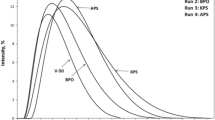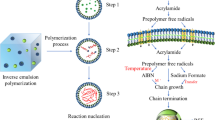Abstract
High molecular weight polyacrylamide (PAM) nanoparticle dispersions are products with wide application possibilities, the most important of which is in petroleum industry such as drilling fluid and flooding agent in enhanced oil recovery. For that aim, it is necessary to achieve complete control of the final dispersion and polymer properties during the synthesis step. In this work, PAMs were synthesized by inverse emulsion polymerization of aqueous acrylamide solution in cyclohexane in the presence of emulsifier mixture of Span 20 and Span 80. We present a comprehensive study of the effects of variation of all important reaction conditions (agitation rate, reaction time and temperature, initiator type and concentration, emulsifier HLB ratio and its concentration, and water to oil ratio) on final monomer conversion, reaction kinetics, polymer intrinsic viscosity and molecular weight, particle size and distribution, and colloidal stability. Finally, the relationships between the reaction conditions and the polymer properties were developed, which allowed determination of the ranges of variation of reaction conditions for optimal PAM properties for the oil industry applications: high molecular weight and intrinsic viscosity, nanosized polymer particles with narrow particle size distribution, and improved colloidal stability of the final dispersions.










Similar content being viewed by others
References
Wada T, Sekiya H, Machi SJ (1976) Synthesis of high molecular weight polyacrylamide flocculants by radiation polymerization. J Appl Polym Sci 20:3233–3240
Virk PS (1971) Drag reduction in rough pipes. J Fluid Mech 45:225–246
Sadeghalvaad M, Sabbaghi S (2015) The effect of the TiO2/polyacrylamide nanocomposite on water-based drilling fluid properties. Powder Tech 272:113–119
Wever DAZ, Picchioni F, Broekhuis AA (2011) Polymers for enhanced oil recovery: a paradigm for structure–property relationship in aqueous solution. Prog in Polym Sci 36:1558–1628
Date JL, Shute JM (1952) Pulp bleaching: principles & practice, Edited by Carlton W. Dence and Douglas W. Reeve. Tappi 42:824–826
Al-Karawi A, Ahemed Jasim M, AI-Daraji AR (2010) Preparation and using of acrylamide grafted starch as polymer drug carrier. Carbohydr Polym 79:769–774
Salehi R, Davaran S, Rashidi MR, Entezami AA (2009) Thermosensitive nanoparticles prepared from poly(N-isopropylacrylamide-acrylamide-vinilpyrrolidone) and its blend with poly(lactide-co-glycolide) for efficient drug delivery system. J Appl Polym Sci 111:1905–1910
Buck S, Pennefather PS, Xue HY, Grant J, Cheng YL, Allen CJ (2004) Engineering lipobeads: properties of the hydrogel core and the lipid bilayer shell. Biomacro 5:2230–2237
Chaw CS, Chooi KW, Liu XM, Tan CW, Wang L, Yang YY (2004) Thermally responsive core-shell nanoparticles self-assembled from cholesteryl end-capped and grafted polyacrylamides: drug incorporation and in vitro release. Biomat 25:4297–4308
Lovell PA, EL-Aasser MS (1998) Emulsion polymerisation and emulsion polymers. Polym Int 45:329–330
Ouyang L, Wang L, Schork FJ (2011) Synthesis and nucleation mechanism of inverse emulsion polymerization of acrylamide by RAFT polymerization: a comparative study. Polym 52:63–67
Hunkeler D (1992) Synthesis and characterization of high molecular weight water-soluble polymers. Polym Int 27:23–33
Pross A, Platkowski K, Reichert KH (1998) The inverse emulsion polymerization of acrylamide with pentaerythritolmyristate as emulsifier. 1. Experimental studies. Polym Int 45:22–26
Platkowski K, Pross A, Reichert KH (1998) The inverse emulsion polymerization of acrylamide with pentaerythritolmyristate as emulsifier. 2. Mathematical modelling. Polym Int 45:229–238
Kurenkov VF, Verizhnikova AS, Myagchenkov VA (1986) Aspects of inversion emulsion polymerization of acrylamide in presence of NaOH and the initiating K2S2O8-Na2S2O5 system. Polym Sci 28:543–548
Chen LW, Yang W (2004) Photoinitiated, inverse emulsion polymerization of acrylamide: Some mechanistic and kinetic aspects. J Polym Sci Part A: Polym Chem 42:846–852
Zhung D, Song X, Liang F, Li Z, Liu F (2006) Stability and phase behavior of acrylamide-based emulsions before and after polymerization. J Phys Chem B 11:9079–9084
Baade W, Reichert KH (1986) Polymerization of acrylamide in dispersion with paraffinic and aromatic liquids as oil phase. Makromol Chem Rapid Commun 7:235–241
Barari M, Abdollahi M, Hemmati M (2011) Synthesis and characterization of high molecular weight polyacrylamide nanoparticles by inverse-emulsion polymerization. Iranian Polym J 20:65–76
Graillat C, Pichot C, Guyot A, El-Aasser MS (1986) Inverse emulsion polymerization of acrylamide. I. Contribution to the study of some mechanistic aspects. J Polym Sci, Part A: Polym Chem 24:427–449
Capek I (2004) Inverse emulsion polymerization of acrylamide initiated by oil- and water-soluble initiators: effect of emulsifier concentration. Polym 36:793–803
Blagodatskikh I, Tikhonov V, Ivanova E, Landfester K, Khokhlov A (2006) New approach to the synthesis of polyacrylamide in miniemulsified systems. Macromol Rapid Commun 27:1900–1905
Scholtan W (1954) Molekulargewichtsbestimmung von polyacrylamid mittels der ultrazentrifuge. Makromol Chem 14:169–178
Trabelsi S, Aschi A, Othman T, Gharbi A (2014) Effect of small globular protein on the dynamical behavior of long-chain polyelectrolyte in dilute regime. Adv Int Polym Tech 33:3–9
Marie E, Rothe R, Antonietti M, Landfester K (2003) Synthesis of polyaniline particles via inverse and direct miniemulsion. Macromol 36:3967–3973
Candau F (1997) Microemulsion polymerization, In polymeric dispersions: principles and application, J.M. Asua, Ed., NATO ASI. Series E, App Sci 335:127–140, Kluwer academic: Dordrech
Krishnan S, Klein A, El-Aasser MS, Sudol ED (2004) Effects of agitation on oxygen inhibition, particle nucleation, reaction rates, and molecular weights in emulsion polymerization of n-butyl methacrylate. Ind Eng Chem Res 43:6331–6342
Benda D, Snuparek J, Cermak V, (2001), Oxygen inhibition and the influence of pH on the inverse emulsion polymerization of the acrylic monomers, Euro. Polym. J., 1247–1253.
Liu X, Xiang S, Yue Y, Su X, Zhang W, Son C, Wang P (2007) Preparation of poly(acrylamide-coacrylic acid) aqueous latex dispersions using anionic polyelectrolyte as stabilizer. Colloids Surf A: Phys Eng Asp 311:131–139
Author information
Authors and Affiliations
Corresponding authors
Ethics declarations
Conflict of interest
The authors declare that they have no conflict of interest.
Electronic supplementary material
Below is the link to the electronic supplementary material.
ESM 1
(DOCX 271 kb)
Rights and permissions
About this article
Cite this article
Tamsilian, Y., Ramazani S.A., A., Shaban, M. et al. High molecular weight polyacrylamide nanoparticles prepared by inverse emulsion polymerization: reaction conditions-properties relationships. Colloid Polym Sci 294, 513–525 (2016). https://doi.org/10.1007/s00396-015-3803-5
Received:
Revised:
Accepted:
Published:
Issue Date:
DOI: https://doi.org/10.1007/s00396-015-3803-5




